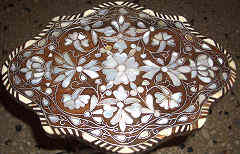 Sedef is the Turkish name of mother of pearl and is widely used in traditional arts as inlay. Especially during the Ottoman period it became very popular and many inlay objects and furniture was made between 15th and 19th centuries. The mother of pearl is obtained from the interior of the pearl oyster shell which was usually imported from Asia, than local artists worked it on the wood making remarkable chairs, tables, boxes, chest of drawers, mirror frames, and so on. This type of art was widespread in all Anatolia and the Middle East.
Sedef is the Turkish name of mother of pearl and is widely used in traditional arts as inlay. Especially during the Ottoman period it became very popular and many inlay objects and furniture was made between 15th and 19th centuries. The mother of pearl is obtained from the interior of the pearl oyster shell which was usually imported from Asia, than local artists worked it on the wood making remarkable chairs, tables, boxes, chest of drawers, mirror frames, and so on. This type of art was widespread in all Anatolia and the Middle East.
The quality of the mother of pearl is very important. All shelled mollusks possess a shell with a sort of mother of pearl, but the freshwater mollusks are one of the best because they provide large flat pearl blanks and are milk white to create a nice contrast on dark wood, thus these are the prefered ones. It's not easy to convert an arched shell to flat pieces for inlay blanks, but it's the craftmen's skill. Also the wood has to be good quality, usually walnut, mahogany or rose wood is selected.
In the Sedef inlay technique, the craftsman (Sedefkar in Turkish) first draws his design on the wood cutting out the lines, then inserts the brass or silver wire in these lines with the help of a small hammer; this is called "tel çekme" or "telkari" technique. Then he slightly cuts out the areas between these wires in order to place the mother of pearl blanks that are cut according to the shape of the design. The craftsman glues them in their spot than waits for a couple of days to dry before sandpapering and waxing. Besides the mother of pearl, also tortoise shell, camel bones and ivory can be mixed to decorate the design of Sedef furniture. Usually floral designs are used.
Today, there are few artists left in this business. Especially Gaziantep is one of the cities where one can still experience hand made art of the mother of pearl inlay tradition.

